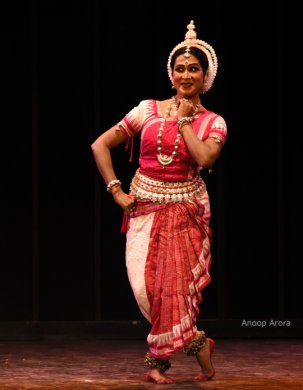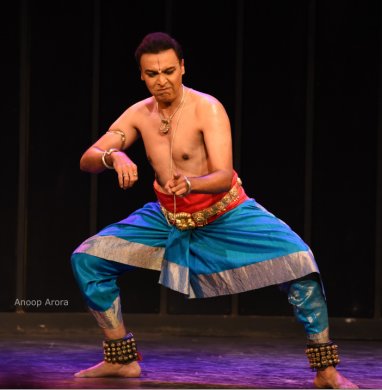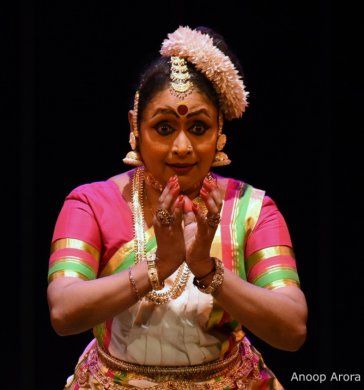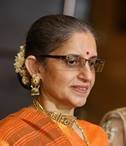
|   |

|   |
Veterans bring Swathi Tirunal’s kritis alive through dance - Shveta Arora e-mail: arorashveta1806@gmail.com Photos: Anoop Arora October 7, 2022 Mohiniyattam exponent Jayaprabha Menon and the International Academy of Mohiniyattam organized the two-day Swathi Tirunal Festival at IHC in Delhi. This festival is being held annually since 2008. It celebrates the poet-king through various disciplines of Indian classical dance and music. When you watch the masters dance, it is a totally mesmerizing experience. You are spellbound in awe. You not only appreciate their proficiency in their form, but also their sadhana and hard work, which put them at ease to express what they want.  Sujata Mohapatra The first to take the stage was Odissi exponent Sujata Mohapatra. Sujata looked beautiful in her white and magenta costume. She did a Ganapati vandana and a Saveri pallavi as the first piece. I regretted missing these two pieces for I could not reach in time. Her last piece was Swathi Tirunal’s “Chaliye kunjan mo.” She depicted the Yamuna through expansive hand movements showing waves. The nayika wades through water, and rows the boat in a storm as it rages. Through the lashing rain she reaches him and takes refuge in his arms. As she fills water in her pot, Krishna stops her in her path and threatens to break the pot. She is all wet from head to toe as he does so. For the next verse, Sujata depicted the gait and the movements of a koel. The piece was presented with a lot of precision and aestheticism. The next performer for the evening was Bharatanayam exponent Vaibhav Arekar. His dhoti was blue, with a magenta cloth around the waist. The performances that I have seen thrive on not only his nritta and nritya proficiency, but are thematic and bring forth his technique in abhinaya and natya. The theme and its execution are always flawless. The accompanists were Sudha Raghuraman on vocals, Dakshinamurthy Pillai on mridangam, Swarada Bhave on nattuvangam and R. Shridhar on violin.  Vaibhav Arekar The first piece was “Karunanidhan kunj ke bihari” in raag Hamir Kalyani in taal roopak. He went on to depict the Kaliyadaman leela, where Krishna, while playing with the ball, deliberately throws it into the Yamuna, goes on to jump and wade in the water and after a fight with the Kaliya snake, dances on its hood, holding its tail in one hand, depicted aptly by the dancer. His flute spreads its magic on the entire creation: tumhari bansi meri manohari moh gayi saari braj ki nari (the melody of your flute has stolen my heart and enchanted the women of all Braj). Showing their expression of looking at him in a trance, with back leg stretches and a seated posture, he depicted the peacock feather and the pitambar and Krishna’s gait, the ear ornaments as they are reflected on his cheeks: kundal ki chhavi balihari. The gopis who look upon the lord are dazzled by his beauty. After every posture, he would do footwork to cover the entire stage. Vaibhav went on to depict the Govardhan leela, where in order to save Braj from the anger of Indra, Krishna gathers the drowning people and cattle of Vrindavan, lifts the Govardhan mountain on his little finger and gives refuge to them. Later, he depicted Padmanabha through the reclining posture on the serpent. Vaibhav portrayed the Krishna leela with expressive abhinaya. Each time he addressed the lord as Karunanidhan, it appeared that he was actually asking for his blessings and his eyes would show the pleading and would become wet. His footwork and stage coverage for the entire piece was immaculate. The second piece was “Anjaneya Raghunatham dutam” in raag Saveri, adi talam. The piece was in the varnam format. Vaibhav started the performance by depicting Rama’s attributes, his bow in one hand and the other raised in the karuna posture. The bhakta asks Hanuman for mercy. As a child, Hanuman, while playing with a ball, became adamant that he wanted the sun, which he thought was a ball. He pleaded, but to no avail, so he grabbed Suryadev and put him in his mouth. Though Suryadev was immediately released, Hanuman’s body became orange-hued. Vaibhav depicted it all beautifully. For the episode of Sanjeevani herb, Vaibhav described the sequence of war in which Kumbhakarna was vanquished but Lakshman then falls to the arrows of Meghnad. Hanuman is sent to get the sanjeevani herb from the Dronagiri mountain. Hanuman flies and descends on the mountain but he cannot tell one plant from the other. Vaibhav depicted the dilemma with a hint of humour: the monkey-faced Hanuman pointing to one plant and then to another, in confusion, and finally, giving up and lifting the entire mountain on to his shoulders. Lakshman is given the elixir made from the herb and is revived. In the last incident from the Ramayana that Vaibhav depicted, he showed Sita in captivity and Hanuman going into the palace of Ravana to give solace to Sita. The entire sequence of Ravana disguising himself as a hermit and kidnapping Sita was enacted. Rama goes around wailing for Sita in the forests. Hanuman flies across the oceans to the palace gardens of Ravana to bring Rama’s ring to her, and assures her that Rama will soon be here for her. Ravana’s army captures him and sets his tail on fire. Here again, Vaibhav brought an element of humour as he tells the story of Lanka burning. Hanuman provokes the people of Lanka to tie more and more cloth to his tail, make it long enough to be swirled around in Lankapuri. And then when they set it alight, he holds up the rear end of his tail and starts to twirl it. As it burns, he holds it up and starts to scorch everything. This particular sequence was done with great abandon. Hanuman emerges after having burnt down all of Lanka. The bhakta beseeches Lord Hanuman to shower his mercy on him again and again. Vaibhav brought his performance to an end with the final posture of Hanuman squatting and tearing open his chest, revealing the ones residing in his heart: Rama, Sita and Lakshman. And that darshan of Lord Rama is the biggest boon that his bhaktas receive from him. Vaibhav’s sound technique is used as is effortlessly. He is everywhere on the stage, on all sides and in all directions. His abhinaya is forceful and transmits the audience into the realm of the tale being told. The vocals by Sudha wove magic.  Jayaprabha Menon Finally, it was Jayaprabha Menon who took the stage with her Mohiniyattam presentation. The first piece she presented was a swarajati. The costume was the traditional white sari with gold, green and red colours. Starting with the melody of an aalap and veena vadan, the piece was an ode to Lord Krishna. She began with a pushpanjali. In the nritta portions, Jayaprabha moved with ease in the swaying movements of Mohiniyattam. Her hands and feet rotated to show the lotuses and the eyes moved simultaneously. The nritta interludes were very lyrical. After the offering of flowers, Jayaprabha touched his feet to her eyes and described his attributes. Yamuna was shown through crests and troughs as Krishna stands with his flute and peacock feather. His body is beautiful, komalang, and his face is like that of a lotus. The ankle bells adorn his feet. She concluded the piece with the posture of Vishnu reclining on the serpent Sesha and the lotus emerging from his navel. The final piece of the evening was the samvad padam. The nayika, as she comes out after a dalliance with Lord Padmanabha, meets her sakhi. The tell-tale signs give her away. The padam refers to the conversation that occurs between the two friends. Jayaprabha chose to do it seated. The music was catchy, with a folksy touch. The sakhi questions the nayika about her dishevelled state. When she is asked about her reddened eyes, she says it is because she had the sun in her eyes. For her scattered hair, she blames the wind. The bindi on her forehead is smudged and she makes her sari responsible for it, which, while wearing, might have wiped it off. And when the friend asks her his name, she coyly runs away. The verses were from the ‘Padmanabha sambhog’. The vocalist ended with a crescendo. Jayaprabha’s mukhabhinaya was eloquent. It was her facial expressions and her flickering eyes that moved to express all the emotions of a shy woman who has been caught in flagrante. A well-enacted piece it was since in Mohiniyattam, it is the face and the eyes which do most of the talking. The vocals and percussion added to the appeal of the presentation. Jayaprabha was accompanied by Kottakkal Jayan on vocals, Swati P. Das on mridangam, Trishul Muralikrishnan on veena and Satish on edakka. The event had Atul Mishra on lights and Innee Singh on photography.  Shveta Arora is a dance-mad writer who chronicles classical dance events in Delhi. Ten years ago, she started the blog Kala Upasana at delhiculturecomment.blogspot.com, where she began posting her own writing along with photographs clicked by Anoop Arora, her husband. She's been dancing all her life as a devotee, but resumed her formal training in Kathak in her 50s and has passed her fourth year Kathak exams. |